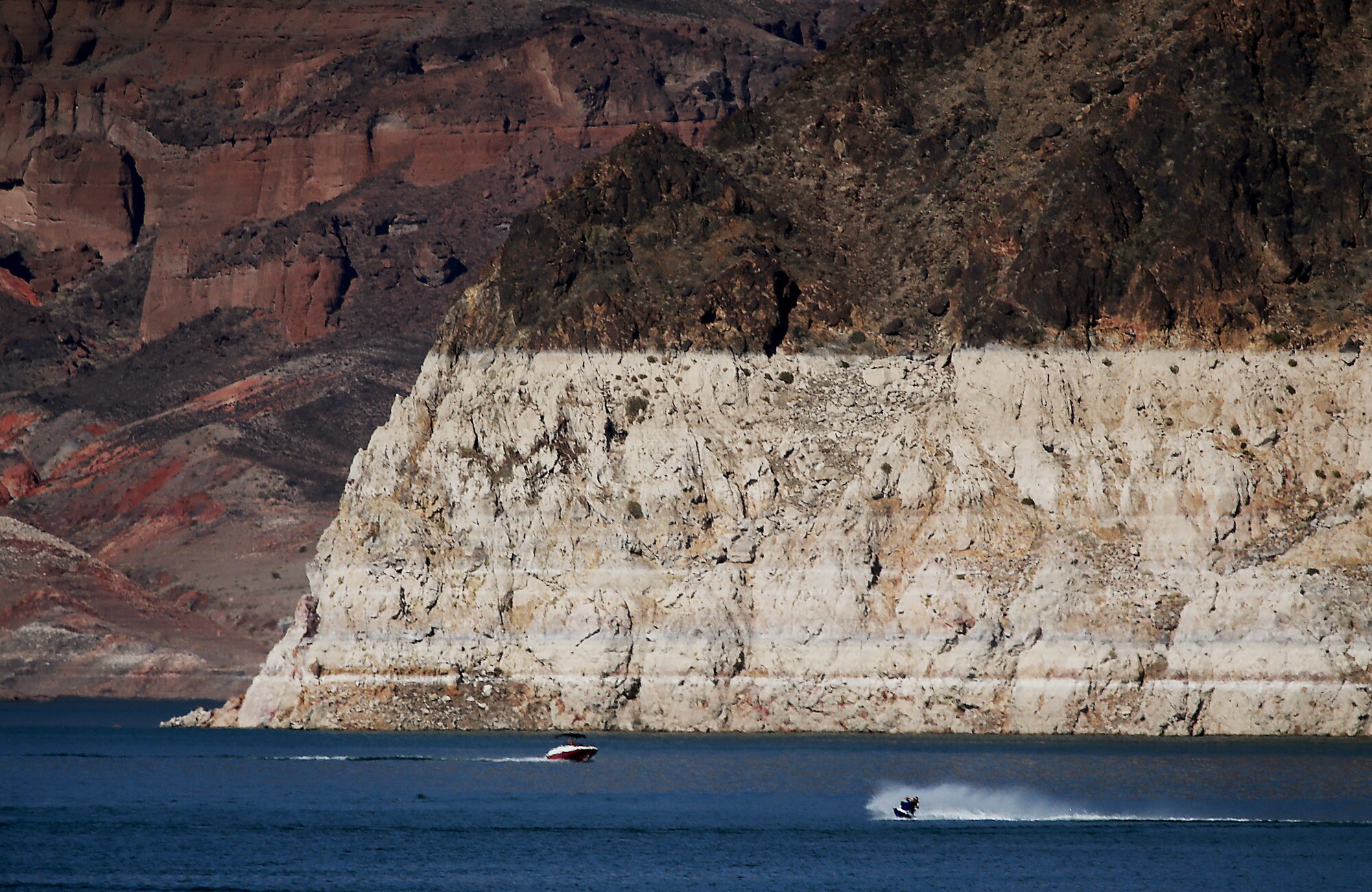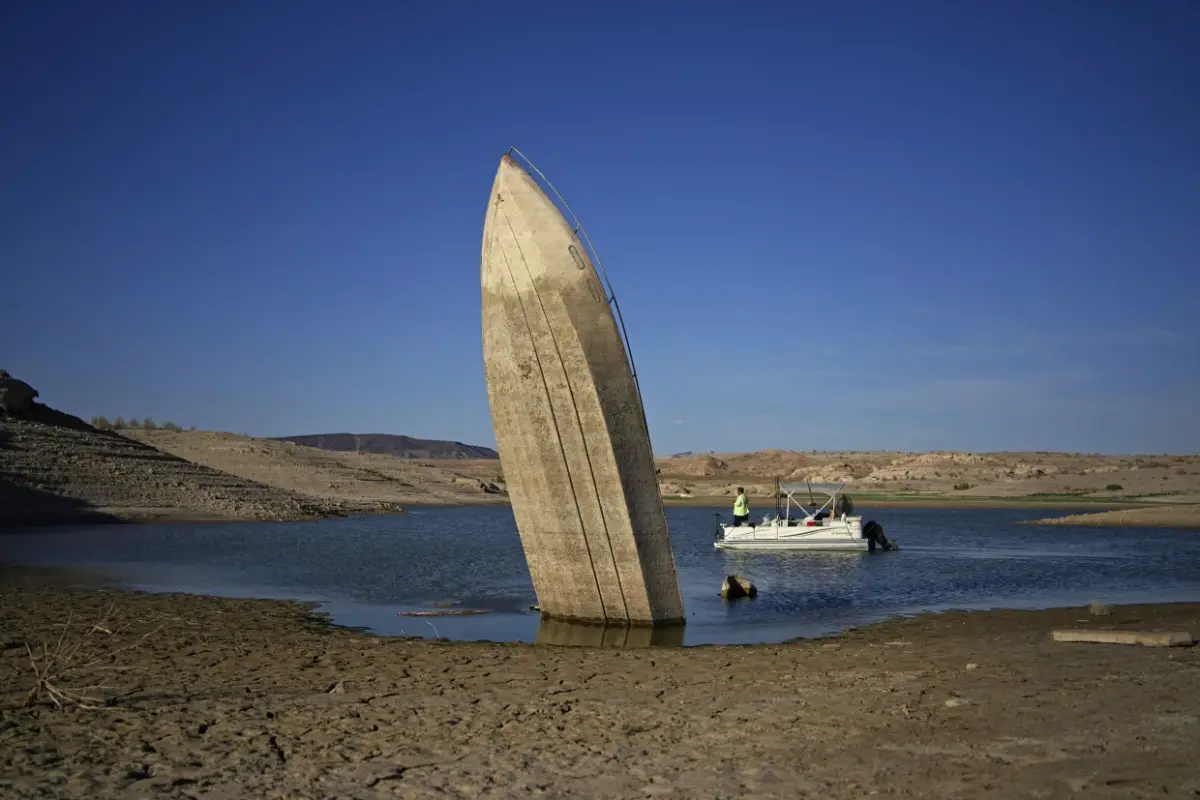According to the U.S. Drought Monitor, more than 20 percent of land in the western U.S. was determined to be in an “extreme or exceptional drought,” called a Mega-drought has been in existence for 22 years creating near Deadpool conditions in the biggest manmade reservoirs in the country. What is a Deadpool water level?
According to the Bureau of Reclamation-A Deadpool occurs when water in a reservoir drops so low that it can’t be released downstream through the dam, a risk that Lake Meade (largest) & Lake Powell (2nd largest) reservoirs on the Colorado River could face within a few years if dry conditions continue.
The biggest concerns are Lake Powell, behind Glen Canyon Dam on the Utah-Arizona border, and Lake Mead, behind Hoover Dam on the Nevada-Arizona border. These two reservoirs, the largest in the United States and provide drinking water, irrigation, and hydroelectricity to millions of people in Nevada, Arizona, and California.
Lake Mead Dead Pool

Lake Meade is vanishing at an extremely fast rate. It’s at the lowest recorded rate since it was built in the 1930s. The last time it was measured at peak capacity or Full Pool at 1225 ft. was back in 1983 but now it is in the countdown to Dead Pool at 1075 ft. in elevation in June 2022. In June 2021, the elevation at Lake Mead receded for a huge 26-foot drop in water level in only one year.
Last summer in late August the Bureau of Reclamation declared its first Federal Water Shortage in History. The Bureau began its first major cutbacks in water usage when the water level dropped in the elevation of Lake Meade below less than 1075 ft. Another more stringent cutback that happened was when the level dropped below 1050 feet in elevation.
The 3rd Tier will be at 950 ft. elevation when the water level will drop below the intakes for the turbines that make Hydroelectricity at the Hoover Dam. Then below that at 900 feet in elevation is the dreaded word that we have heard a lot from environmentalists lately called Dead pool.
Why Is Lake Mead So Low
Read more about Lake Meade and the effect it has on the Southwest-The largest reservoir in the United States Lake Mead was formed when the Hoover Dam was built in the 1930s providing water and power to the Southwestern states of California ……………… Continue reading
A Dead pool occurs when water in a reservoir drops so low that it can’t flow downstream from the dam or exit the reservoir. The Hoover Dam provides enough electrical power to 1.3 million people in Southern California, Arizona, and Nevada. It also provides the juice needed to keep the City of Las Vegas lit up and active 24-7 365 days a year.
While current estimates from the Bureau of Reclamation show the lake rebounding slightly over the next few months, it projects water levels could drop to 1014.86 feet by September 2023 which is a nearly 23-foot drop compared to its Sept. 2022 estimate.
Lake Mead Water Level
More than 40 million people rely on the Colorado River Basin System for potable Drinking Water including water needed for Hydroelectric Power, Farming, Reservations, Companies, Recreation, and Cities. Lowering water levels at the reservoir will affect many related important things like shorelines marinas besides energy and water setbacks that will affect the entire Southwestern region of the United States.
Environmental scientists fear that this area of the country will lose the ability to create “Clean Energy” made by hydroelectric dams so vital to this dry arid desert region of the southwest. If things don’t improve planners are looking toward Solar and Wind energy that is not with the possibility of Desalinization plants on the ocean.
The Southwest region of the US has been suffering from a 22-year-long drought in the Colorado River basin reaching minimum power pool elevation is the first problem. Lake Mead has turbines at the bases of its dam, well below the surface of the reservoirs. Water flows through valves in intake towers in the reservoirs and is channeled through the turbines, making them spin to create electricity. Lower water levels can threaten the creation of energy besides threatening drinking water.
The low water levels on Lake Meade have closed businesses and marinas and even prompted the WON U.S. Open bass fishing tournament to move to Lake Mohave for 2022, according to KLAS-TV local news. The tournament has been held at Lake Mead for the last 39 years
U.S. Bureau of Reclamation is the water managers across the southwestern region of the United States are making efforts to manage the flow of water into the Colorado River and regulate water use in the Southwest.
These measures are designed to help replenish Lake Mead, which was created on the lower Colorado River on the Arizona-Nevada border when the Hoover Dam was built in the early 1930s, the problem they are trying to solve the problem with another severely depleted reservoir, Lake Powell, which was created along the border of Utah and Arizona on the upper Colorado River.

Lake Powell Water Level

Typically, yearly inflows to Lake Powell are fed by the Colorado River, and the western slopes of the Rocky Mountains and San Juan Mountains of Colorado, the mountains of southwestern Wyoming, and eastern Utah are historically covered in deep snow.
The Lake Powell Reservoir operates as a key cog in a vast system that supplies water to 30 million people and irrigates 5 million acres.
Lake Powell is an artificial reservoir built on the upper part of the Colorado River system in the United States. It is a major vacation destination visited by approximately two million people every year.
It is the second largest artificial reservoir measured by maximum water capacity in the United States right behind Lake Mead, storing 25,166,000 acre-feet of water when full.
While its watershed saw a wetter-than-normal October, it was followed by the second-driest November on record, resulting in a loss of around 1.5 million acre-feet of water flowing into Lake Powell for November.
Lake Powell was created by the construction of the Glen Canyon Dam which was completed in 1966 after 10 years of round-the-clock construction.
The Dam system was constructed to harness water from the Upper Colorado River and generate hydroelectricity at the Dam. It took an incredible 17 years of using the Colorado River flow to fill Lake Powell.
Lake Powell is at its lowest water elevation since Colorado’s water was still rising behind the newly constructed Glen Canyon Dam more than 50 years ago. It first reached capacity at 3,700 feet above sea level in 1980 and remained nearly full until the turn of this century.
Lake Powell Deadpool
According to the Bureau of Reclamation, as of Jan. 5, 2022, Lake Powell’s elevation was 3,536 feet or 164 feet below-Full the pool elevation of 3,700 feet. The bureau has established a  target elevation of 3,525 feet, the critical stage elevation, which is 11 feet below the Jan. 5 level, leaving a 35-foot buffer above MPPE.
target elevation of 3,525 feet, the critical stage elevation, which is 11 feet below the Jan. 5 level, leaving a 35-foot buffer above MPPE.
The dead pool is at an elevation of 3,370 ft., some 120 feet below MPPE (minimum power pool elevation). On Jan. 5, the lake was 166 feet above Dead pool. At the dead pool, the low water level results in no water being able to flow out of Glen Canyon Dam.
Tom Buschatzke, director of the Arizona Department of Water Resources told Tucson.com gathering on water law late last month that real fears exist among officials that Lake Powell and Lake Mead could fall to dead pool if not enough is done to arrest their recent sharp, continuing declines.
This summer, the water levels hit a historic lows amid a climate change-fueled megadrought engulfing the U.S. West Federal forecasts for both reservoirs for the next five years look grim, but they do not predict anything close to dead pool levels. However, recent drying trends make some experts wonder if the official forecasts are too optimistic.
Buschatzke met informally with water representatives from the 3 Lower Colorado River Basins including Nevada, Arizona, and California along with the Tribal water representatives to discuss ways how to handle these steady declines in the region’s water supply affecting millions of people. The discussions are candid and serious.
The Lake Powell Water Database keeps up do date reading on the elevation of the reservoir within 2 inches along with Web Cams, Water Inflow Data, Upper Colorado River Snowpack, and the Glen Cayon Water Release Data.
Does Las Vegas Get all of its Water From Lake Mead
Read more about Lake Mead and its effect on the city of Las Vegas-Although the water levels in Lake Mead have been falling for decades, Las Vegas is not about to run dry anytime soon as residents of Las Vegas have been taking ……………..………..… Continue reading
JimGalloway Author/Editor

References:
Lake Powell Chronicles- Bureau modifies outflow from Glen Canyon Dam
NBC NEWS- Lake Mead nears dead pool status as water levels hit another historic low

